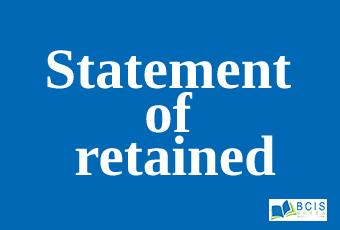
Statement of retained
The statement of retained earnings (retained earnings statement) is a financial statement that outlines the changes in retained earnings for a company over a specified period. The statement of retained earnings is also known as a statement of owner’s equity, an equity statement, or a statement of shareholders’ equity. This statement reconciles the beginning and ending retained earnings for the period, using information such as net income from the other financial statements, and is used by analysts to understand how corporate profits are utilized. Boilerplate templates of the statement of retained earnings can be found online. It is prepared in accordance with generally accepted accounting principles (GAAP).
Understanding Statement of Retained Earnings
This statement of retained earnings can appear as a separate statement or as inclusion on either a balance sheet or an income statement. The statement is a financial document that includes information regarding a firm’s retained earnings, along with the net income and amounts distributed to stockholders in the form of dividends. An organization’s net income is noted, showing the amount that will be set aside to handle certain obligations outside of shareholder dividend payments, as well as any amount directed to cover any losses. Each statement covers a specified time period, as noted in the statement.
Benefits of a Statement of Retained Earnings
The purpose of releasing a statement of retained earnings is to improve market and investor confidence in the organization. It is used as a marker to help analyze the health of a firm. Retained earnings do not represent surplus funds. Instead, the retained earnings are redirected, often as a reinvestment within the organization.
The retained earnings for a capital-intensive industry or a company in a growth period will generally be higher than some less-intensive or stable companies. This is due to the larger amount being redirected toward asset development. For example, a technology-based business may have higher asset development needs than a simple t-shirt manufacturer, as a result of the differences in the emphasis on new product development.
While a t-shirt can remain essentially unchanged for a long period of time, a computer or smartphone requires more regular advancement to stay competitive within the market. Hence, the technology company will likely have higher retained earnings than the t-shirt manufacturer.
Retained Earnings
These funds may also be referred to as retained profit, accumulated earnings, or accumulated retained earnings. Often, these retained funds are used to make a payment on any debt obligations or are reinvested into the company to promote growth and development.
Whenever a company generates surplus income, a portion of the long-term shareholders may expect some regular income in the form of dividends as a reward for putting their money in the company. Traders who look for short-term gains may also prefer getting dividend payments that offer instant gains. Dividends are paid out from profits, and so reduce retained earnings for the company.
The following options cover the possibilities on how the surplus money allocated to retained earnings and not paid out as dividends can be utilized:
It can be invested to expand the existing business operations, like increasing the production capacity of the existing products or hiring more sales representatives.
It can be invested to launch a new product, like a refrigerator maker into producing air conditioners, or a chocolate cookie manufacturer.
The money can be utilized for any possible merger, acquisition, or partnership that leads to improved business prospects.
It can also be used for share buybacks.
The earnings can be used to repay any outstanding loan (debt) the business may have.
Preparation of Income Statement with Vertical multi-step format
The multi-step income statement details the gains or losses of a business, in a specific reporting period. It offers an in-depth analysis of a business’s financial performance. Its format separates a company’s operating revenue and operating expenses from its non-operating revenue and non-operating expenses.
Here are the steps you need to follow to create a multiple-step income statement for your business.
1. Select your reporting period
2. Create a document header
3. Add operating revenues
4. Add operating expenses
5. Calculate gross profit
6. Calculate operating income
7. Add non-operating revenues and expenses
8. Calculate net income
You may also like Revenues

Leave a Reply